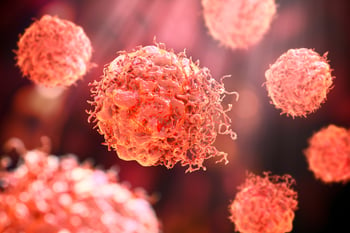Examining the tumor microenvironment with patient-derived xenografts (PDX)
Representing clonal diversity in the tumor microenvironment of a xenograft model improves the translatability of a study and is an important component of personalized medicine. Patients willing to contribute a portion of their biopsies for research purposes are contributing not only cancer cells, but the surrounding ecosystem, giving researchers insight into the supporting role of the stroma and extracellular matrix in the development of their disease.

Tumor cells were once thought of as nearly exact replicates of their prior cells, but research over the last few decades has demonstrated vast tumor heterogeneity — both between and within tumors. Within the tumor microenvironment, cells can vary based on differences within the tumor itself, depending on many factors, such as genetic mutations, protein level changes, transcriptional alterations, and epigenetic modifications.1 Even genetically identical tumor cells may display different behavior based on where they are in the body, as their surrounding environment has different noncancerous tissues, cells, and molecules.
Tumor heterogeneity creates challenges for developing therapies that can effectively target and eradicate all tumor cells. While a therapy might target the cells collected in a needle biopsy, other more aggressive phenotypes in a tumor may remain undetected, potentially displaying resistance to a therapy and metastasizing to create a more invasive tumor, leading to poor clinical outcomes.
Studying triple-negative breast cancer (TNBC) with patient-derived xenograft (PDX) models
Tumors in patients with triple-negative breast cancer (TNBC) represent one well-studied example of inter-tumor heterogeneity. Of the 1 in 8 women (13%) in the U.S. that develop invasive breast cancer, the aggressive subtype TNBC accounts for 15-20% of all breast cancers and has a worse overall survival rate as compared to other breast cancer subtypes.2
To better understand the mechanisms of chemo resistance in TNBC, which has no approved molecularly targeted therapy to date, patient-derived xenografts can mimic the heterogeneity of the tumor microenvironment.
“We know that clonal diversity in the tumor microenvironment can contribute to metastasis and drug resistance in cancer patients,” said Aaron McCoy, Global Product Manager at Inotiv. “When patient-derived xenograft (PDX) models were added to the repertoire of tools available, it helped uncover new discoveries and advanced the field of research.”
PDX modeling has allowed researchers to develop a more accurate recapitulation of human disease condition, as compared to cell-line derived xenografts (CDX), to better understand the molecular basis of chemo resistance that is typical in cancers like TNBC.
“By characterizing residual tumors that do not respond to treatment in PDX models, researchers can determine if resistance is due to genomic or non-genomic mechanisms and potentially identify vulnerabilities in the tumor that can be targeted therapeutically,” said Aaron, summarizing the TNBC research he contributed to at the University of Texas MD Anderson Cancer Center.3
Advancing research with Washington University Human in Mouse (WHIM) PDX models
While PDX models are capable of retaining the molecular heterogeneity of their originating sample, they are best suited for basic and translational research as they cannot replicate the entirety of the heterogeneity in a typical tumor microenvironment.4
To address ongoing unmet clinical needs and support critical research, Inotiv offers the comprehensive support for its PDX models, which include the highly regarded Washington University Human in Mouse (WHIM) PDX models. These lines were mostly obtained from patients with advanced disease or larger primary tumors that rapidly developed lethal metastasis. The vast collection also encompasses all the major molecular subtypes of breast cancer cells and is well-characterized with several notable attributes, like treatment resistance and sensitivity, to help researchers advance preclinical oncology and better understand drug efficacy.
Learn more about the WHIM breast cancer PDX models
Explore the Wistar Institute Melanoma (WM) PDX collection
Inotiv works in collaboration with the Wistar Institute as the exclusive distributor of their melanoma PDX collection. This collection was established from targeted therapy relapsed melanoma patients, spanning BRAF inhibitors, BRAK/MEK inhibitors, immune checkpoint inhibitors, and targeted therapy and immunotherapy (TT/IT) combinations.
Learn more about the WM melanoma PDX models
The Future of PDX
Advances in immuno-oncology provide a space for the marriage of techniques, such as human cancer engraftment and human immune system engraftment. Engrafting a human immune system into an immunodeficient mouse model, such as a B-NDG, allows researchers to study cancer therapies that utilize human immune system components. These immuno-therapies are well-established in blood cancers like leukemia, but not as effective in the treatment of solid tumors. Many of the advances in immuno-oncology will be made utilizing models that have both human cancer and a human immune system.
References
[1] Sun XX, Yu Q. Intra-tumor heterogeneity of cancer cells and its implications for cancer treatment. Acta Pharmacol Sin. 2015;36:1219–27.
[2] Mehraj U, et al. Chemokines in triple-negative breast cancer heterogeneity: New challenges for clinical implications. Seminars in Cancer Biology, 2022, https://doi.org/10.1016/j.semcancer.2022.03.008
[3] Echeverria GV, et al. Resistance to neoadjuvant chemotherapy in triple-negative breast cancer mediated by a reversible drug-tolerant state. Sci Transl Med. 2019 Apr 17;11(488):eaav0936. doi: 10.1126/scitranslmed.aav0936.
[4] Cassidy JW, et al. Maintaining Tumor Heterogeneity in Patient-Derived Tumor Xenografts. Cancer Res 1 August 2015; 75 (15): 2963–2968. https://doi.org/10.1158/0008-5472.CAN-15-0727


